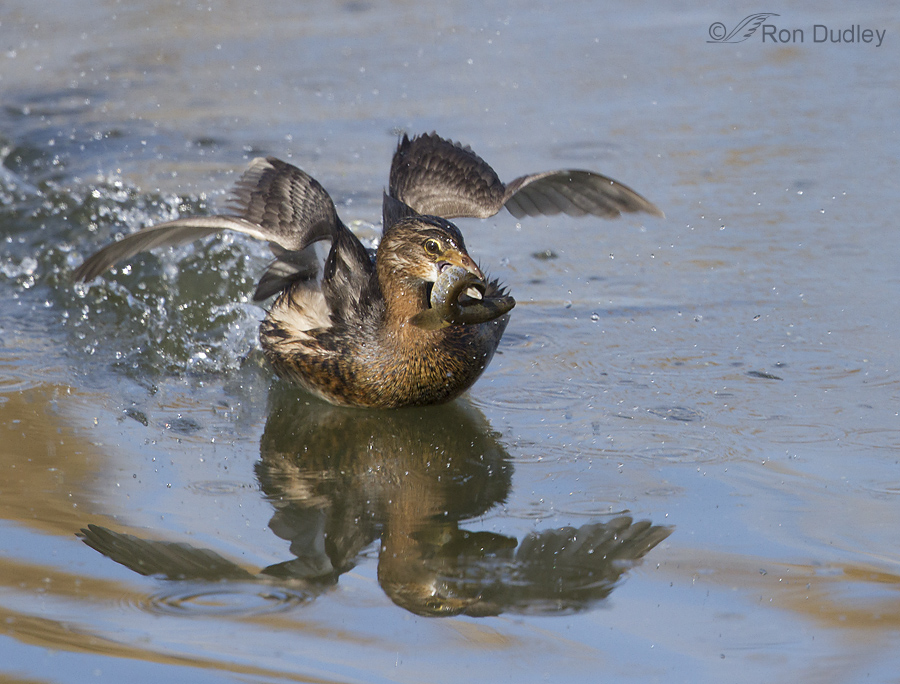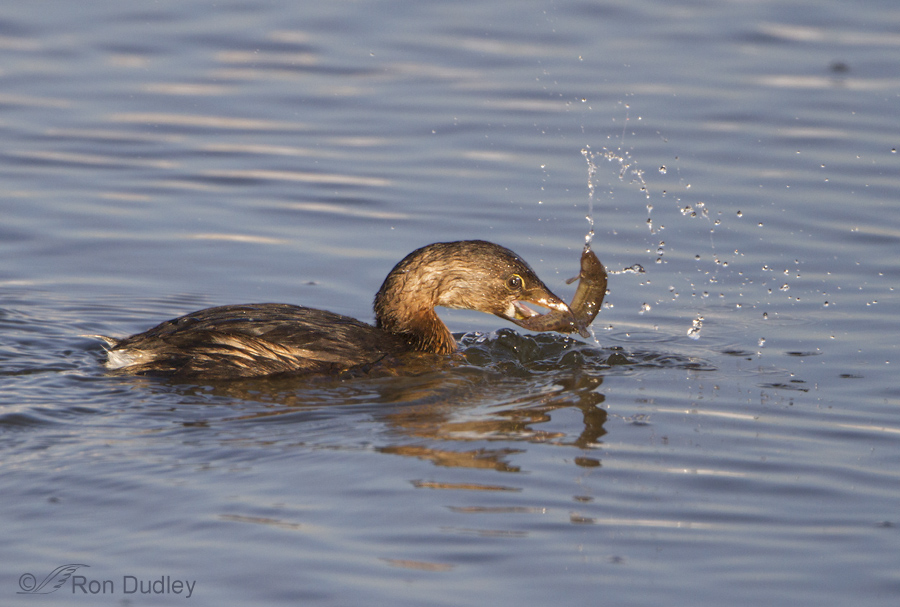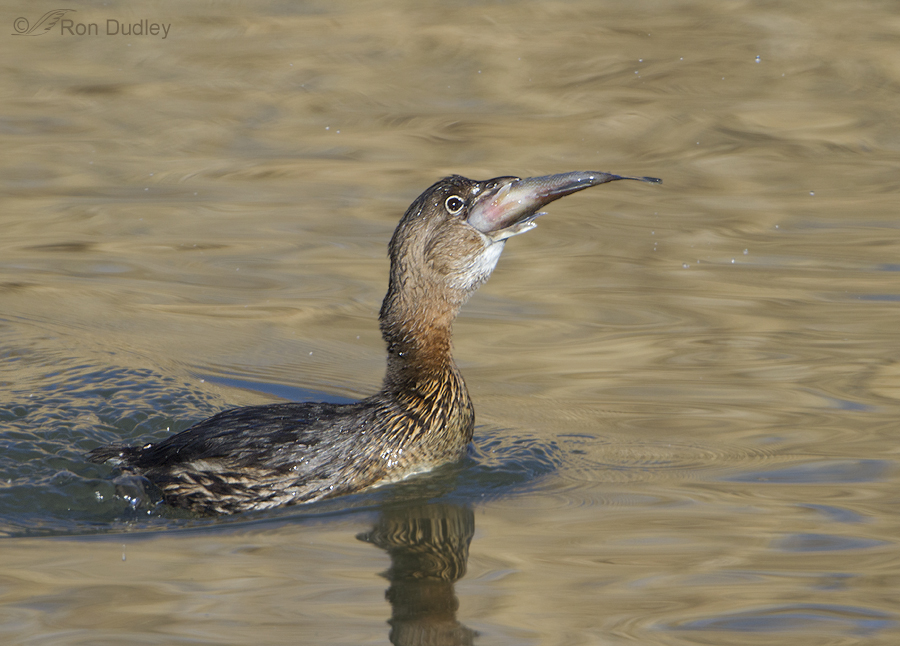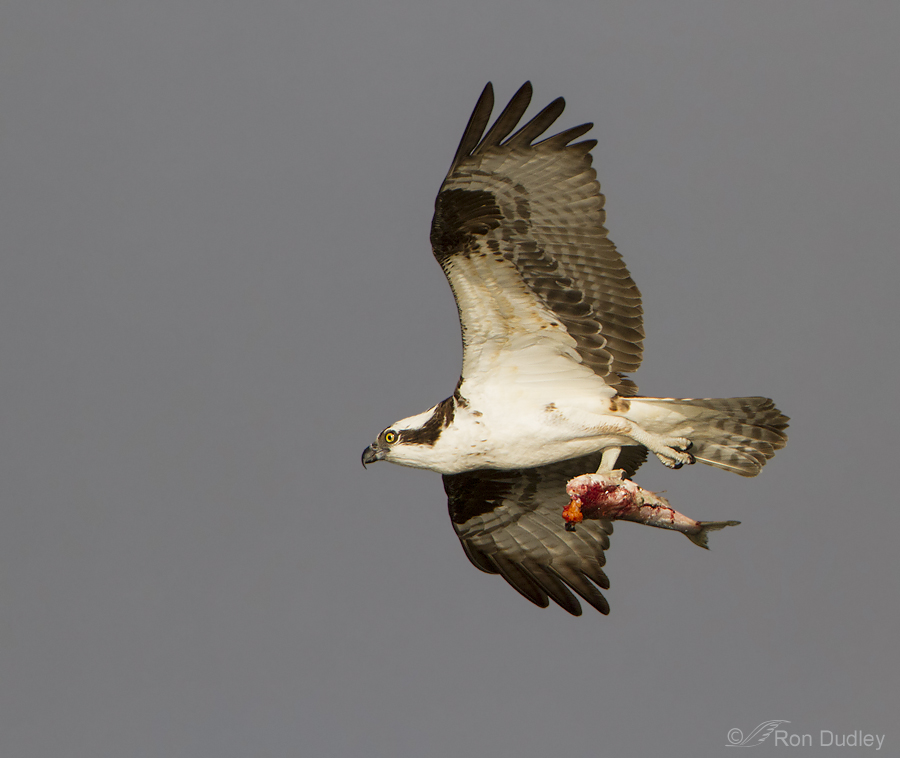Tag: fish
Pied-billed Grebe Feeding Behavior And An Invasive Species
Bald Eagle Potpourri
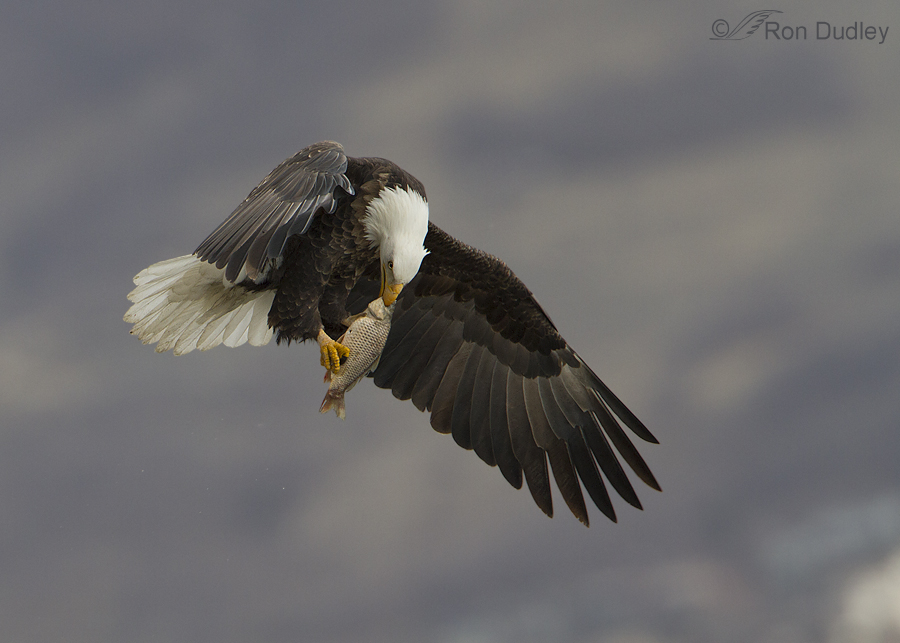
Yesterday morning I saw my first Bald Eagle of the season at Farmington Bay. It was too far away for even mediocre images but it was there! We have a small number of resident eagles in northern Utah but those few birds normally don’t hang out at Farmington this early in the season so I’m not sure if it was a wandering resident or an early migrant. Either way it was a delight to see.
As a result, when I began thinking about today’s post my mind kept returning to eagles so I thought I’d present several images taken at Farmington two winters ago.
Pied-billed Grebe With Eyes Bigger Than Its Than Stomach
Osprey In Flight With Trout
Great Blue Heron Canopy Feeding?
I’ve spent a fair number of years now photographing Great Blue Herons and I’d never before seen this behavior from the species.
One-footed Merganser In A Hurry
I live near a local fishing pond that attracts a few fish-eating birds, particularly in the late winter and early spring. For the last few days there’s been a pair of Common Mergansers on the pond and yesterday morning I was finally able to get relatively close to them for a few minutes. The pond was still about half covered with ice but it’s melting fast. 1/2500, f/7.1, ISO 500, 500 f/4, 1.4 tc, natural light Most of the time there wasn’t much action with the cormorants but once, when this bird apparently thought its companion might have caught a fish, it rushed over to investigate. It wasn’t until this morning when I began culling and processing the images that I noticed that it was missing its left foot. 1/2500, f/7.1, ISO 500, 500 f/4, 1.4 tc, natural light Since they use their webbed feet to help propel them along the surface of the water this bird could really scoot for having only one foot. 1/2500, f/7.1, ISO 500, 500 f/4, 1.4 tc, natural light This image shows the missing foot best. 1/2000, f/7.1, ISO 500, 500 f/4, 1.4 tc, natural light This shot, and the next two, are of the other merganser. As you can see it had some kind of fishing lure/hook stuck in its lower mandible. It doesn’t look like a typical lure so perhaps it’s what’s left of a fish that it had tried to swallow when the hook and/or line got stuck in its bill. 1/2000, f/7.1, ISO 500, 500…
Terns – After The Dive
Terns tend to be graceful and highly maneuverable flyers and those skills are very much on display when they’re fishing. 1/5000, f/6.3, ISO 500, 500 f/4, 1.4 tc, natural light I found this Forster’s Tern fishing at Bear River MBR last June and decided I’d attempt to photograph it coming out of the water after a dive – easier said than done. And to catch it with a fish would be a bonus. This species is known for feeding on “small” fish but this one is ridiculous – hardly worth the bother. If you look very carefully you can see the miniscule fish behind the upper part of the bill. I’ve cropped this shot unconventionally in order to include the “splash” behind the bird. These birds fish relentlessly. Their quarry is small, as is their success rate. In one Forster’s Tern study, 1538 dives produced 369 fish for a success rate of 24%. 1/5000, f/6.3, ISO 500, 500 f/4, 1.4 tc, natural light The fish is more easily seen in this next shot. When they come off the surface they usually shake excess water out of their feathers in mid-air. I caught this tern just before the shake, where it has twisted its wings in order to get good action for the upcoming shake. I missed the shake with this bird but… 1/1250, f/6.3, ISO 500, 500 f/4, 1.4 tc, natural light I did manage to capture it on another day with this Caspian Tern. I didn’t have enough shutter speed to get the quick movements particularly sharp but…
Western Grebe Fish Delivery
Temperatures are finally warming a bit here in northern Utah but the world is outside is still monotonously white. Yesterday morning I measured 22 1/2″ of snow on the north end of Antelope Island, indicating that our bleak and largely featureless landscape will remain the same for the foreseeable future. So this morning I needed a break and decided to post an image (taken this past June at Bear River MBR) that would remind me that spring is somewhere out there on the distant horizon. 1/3200, f/7.1, ISO 640, 500 f/4, 1.4 tc, natural light Western Grebes are devoted parents to their incessantly hungry and noisy chicks. The male and female take turns with their parental duties – one will back brood the youngsters while the other delivers fish and then they alternate responsibilities. Here the female (smaller than the male, with a shorter, thinner bill – thus sexual dimorphism) has caught a small fish and is delivering it to the male. Usually the parent receiving the fish will give it to the chick, as happened here. As I’m sure is obvious, I’m very much looking forward to watching and photographing springtime bird activities once again. It’s going to be a very long 2-3 months… Ron
Great Blue Herons On Snow and Ice
Christmas Morning at Bear River Migratory Bird Refuge was nothing short of spectacular. We had great light, wonderfully clear blue skies and lots of birds. And it was cold – as low as 6 degrees F. Perfect! On this trip (which included the Promontory Point area) we saw a plethora of raptors – Bald and Golden Eagles, Red-tailed Hawks, Rough-legged Hawks, American Kestrels, Short-eared Owls, a Prairie Falcon and one Barn Owl hunting in daylight because of the cold. And I’ve never seen as many Great Blue Herons in one relatively small area as I did on that morning. Just before I stopped to take this photo there were over 100 of them on the ice of the canal to the right and along the far bank in less than 1/3 mile – which led to a topic of conversation. Mia is from Florida and we discussed how seeing Great Blue Herons on snow and ice seems incongruous to many folks from warmer climates. That conversation was the inspiration for this post. 1/4000, f/6.3, ISO 400, 500 f/4, natural light As is typical for western herons, these birds were difficult to approach (in some areas like Florida one can almost walk up and touch them at times). This juvenile was fishing in a patch of flowing water surrounded by ice and snow. 1/2500, f/6.3, ISO 400, 500 f/4, natural light Then the same bird flew off and then came back to land within a few feet of where it had been fishing – almost like it was…
Northern Harriers Hunting
It’s getting to be what I call “harrier time” here in northern Utah so I thought I’d do a significant post on the species. For me, watching these birds hunt is absolutely mesmerizing and I could do it for hours. And I have – many, many times. But before I get into hunting I’d like to cover some basics on telling the sexes and ages apart. Sexual dimorphism in harriers is exceptional among birds of prey – telling adult males from adult females is easy because their colors are so dramatically different. But because juveniles of either sex strongly resemble adult females, that distinction becomes very tricky and causes a lot of confusion. So, here’s a primer: Adult males – gray above, mostly white below, black wing tips, lemon-yellow eyes Adult females – brown above, buffy with brown streaks below, lemon-yellow eyes (but in my experience, the eyes of adult females tend to be less bright than those of adult males) Juvenile of both sexes – similar to adult female but darker chocolate-brown above and strongly rufous (reddish) below Juvenile male – pale, greenish-yellow eyes Juvenile female – dark, chocolate-brown eyes All sexes and ages have the unique facial disc (ruff) characteristic of harriers. It’s not as prominent as it is in many owls but it can clearly be seen in this image. Its function is the same as it is in owls – to direct sound to the ears. Most hawks hunt almost exclusively by sight but because of their excellent hearing, thanks largely to the facial disc, harriers depend at least…
A Gluttonous Pied-billed Grebe
Pied-billed Grebes are opportunistic feeders so they’re not very fussy about what they eat, but they do seem particularly fond of crayfish, fish and frogs (including tadpoles). Before consuming crayfish and frogs (both are often too large to swallow whole) they rip them apart in an incredibly rapid shaking frenzy that tears off limbs and pieces before they’re swallowed (something I’ve documented here with a frog). They have very strong jaw muscles and before swallowing fish they repeatedly pinch them with their beak, which kills them by damaging their internal organs. Occasionally, when choosing prey, their eyes are bigger than their stomachs – as you’re about to see. (all images are presented in the order that they occurred) All images presented in this post had the following techs: f/6.3, ISO 500, 500 f/4, 1.4 tc, shutter speed ranged from 1/2000 to 1/1250 Last winter, I noticed this grebe just after it surfaced with a fish. A very large fish, at least relative to the size of the bird who must now swallow it. (I’ve never seen one tear a fish into smaller pieces before eating it). As a side-note, I liked the “extra eye” in the reflection at the bottom of the frame. I thought this image would give the viewer a good sense for the size of the fish – especially its width! But the poor bird didn’t have any time at all to get the meal down before other grebes rushed in to try to steal the fish. The competition at times like this is…
Clark’s Grebes – Parents Feeding Fish To Some Very Excited Chicks
This past June I spent lots of time with Western and Clark’s Grebes as they were raising their families. The two species are quite similar but the adult birds in this post can be recognized as Clark’s Grebes by their bright yellow-orange bills and the fact that their eyes are surrounded by white plumage, rather than black. 1/2000. f/7.1, ISO 500, 500 f/4, 1.4 tc, natural light This female of a mated pair was fishing for her family as the male back-brooded two chicks (the sexes take turns with each role). I happened to catch her just as she emerged from the water with a fish and shook the water off. I wish I had better eye contact and more room around the grebe, but this image is full frame. I include it here because it’s the logical beginning of this “fish story”. 1/2000. f/8, ISO 500, 500 f/4, 1.4 tc, natural light Seconds later she swam over to deliver the fish to her family. Sometimes the fish will be given to the brooding parent, who may eat it or give it to a chick. Other times, the fishing parent gives it directly to one of the youngsters. Either way, if the chicks are hungry they become very excited and aggressive in their attempts to be the one who gets the fish. Before the young birds saw breakfast coming their way, they were tucked down peacefully under each wing with only their heads and necks sticking out. All that changed in an instant. 1/2000….
Western Grebe Chick Reacts To Food
I’ve always enjoyed spending time with Western Grebes but until this past summer I’ve had very little success in photographing parents back-brooding their chicks. In June at Bear River Migratory Bird Refuge my luck with this behavior changed and I was able to get quite a few nice images of the chicks on the backs of the parents over many days. Here, two chicks wait patiently on the back of one of the parents while the other one attempts to catch fish for breakfast. The fishing parent would feed small fish to both chicks and to the brooding parent. The chicks watch attentively for the adult to emerge from the nearby water with something to eat. I was always torn about what to photograph – the parent with the fish or the reactions of the chicks to approaching food. In this case I chose the latter. Here, the chick on the right has just spotted its parent come up out of the water from behind with a small fish and is beginning to react. Usually, both chicks were hungry and competed for the food but this time the youngster on the left was full and not interested in anything to eat. But the chick on the right didn’t know that and went into full competetive begging mode. I always enjoyed watching these reactions to food. Ron
Clark’s Grebe Chicks Competing For Food
One of the Clark’s Grebe behaviors I was able to photograph last week was the adults feeding their chicks. The youngsters would be on the back of one parent while the other one brought in fish for breakfast. They were always small fish, to accommodate the very young chicks. Some of these aren’t great photos but collectively I think they tell an interesting story. I had been shooting faster action just prior to this sequence so my settings for the first shot aren’t particularly appropriate but then I quickly adjusted. 1/4000, f/6.3, ISO 640, 500 f/4, 1.4 tc The parent bringing in the fish wouldn’t give them directly to the chicks but instead would hand them off to its mate and then that bird would feed the youngsters on its back. Here the parent on the left has just given this small fish to the brooding adult. 1/2500, f/8, ISO 640, 500 f/4, 1.4 tc The chick in the water knew it had no chance to get the fish while it was there so it immediately made a bee-line for the back of its parent. When they’re this size they still struggle to get on board. Sometimes the parent sticks a leg out backward for the chick to climb up on but this youngster was on its own and was frantic to get up front where the food would be doled out. 1/2500, f/8, ISO 640, 500 f/4, 1.4 tc I imagine it’s not easy getting up there since they have to work against the grain of the feathers of the…


